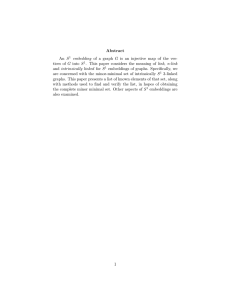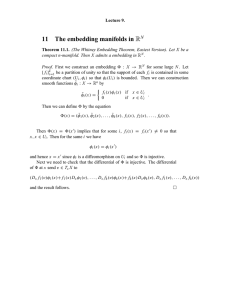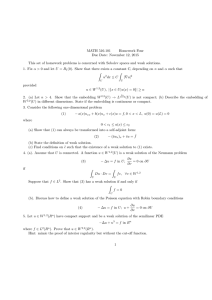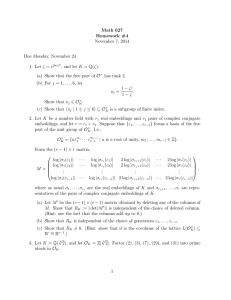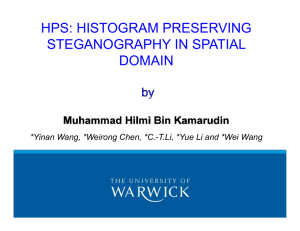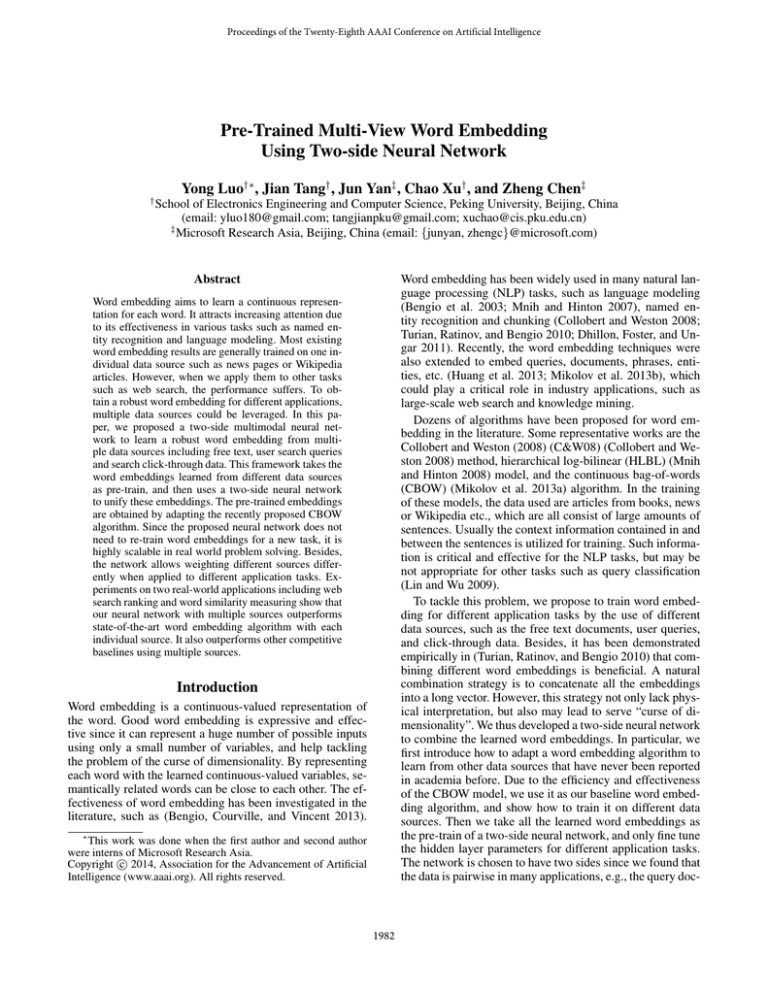
Proceedings of the Twenty-Eighth AAAI Conference on Artificial Intelligence
Pre-Trained Multi-View Word Embedding
Using Two-side Neural Network
Yong Luo†∗ , Jian Tang† , Jun Yan‡ , Chao Xu† , and Zheng Chen‡
†
School of Electronics Engineering and Computer Science, Peking University, Beijing, China
(email: yluo180@gmail.com; tangjianpku@gmail.com; xuchao@cis.pku.edu.cn)
‡
Microsoft Research Asia, Beijing, China (email: {junyan, zhengc}@microsoft.com)
Abstract
Word embedding has been widely used in many natural language processing (NLP) tasks, such as language modeling
(Bengio et al. 2003; Mnih and Hinton 2007), named entity recognition and chunking (Collobert and Weston 2008;
Turian, Ratinov, and Bengio 2010; Dhillon, Foster, and Ungar 2011). Recently, the word embedding techniques were
also extended to embed queries, documents, phrases, entities, etc. (Huang et al. 2013; Mikolov et al. 2013b), which
could play a critical role in industry applications, such as
large-scale web search and knowledge mining.
Dozens of algorithms have been proposed for word embedding in the literature. Some representative works are the
Collobert and Weston (2008) (C&W08) (Collobert and Weston 2008) method, hierarchical log-bilinear (HLBL) (Mnih
and Hinton 2008) model, and the continuous bag-of-words
(CBOW) (Mikolov et al. 2013a) algorithm. In the training
of these models, the data used are articles from books, news
or Wikipedia etc., which are all consist of large amounts of
sentences. Usually the context information contained in and
between the sentences is utilized for training. Such information is critical and effective for the NLP tasks, but may be
not appropriate for other tasks such as query classification
(Lin and Wu 2009).
To tackle this problem, we propose to train word embedding for different application tasks by the use of different
data sources, such as the free text documents, user queries,
and click-through data. Besides, it has been demonstrated
empirically in (Turian, Ratinov, and Bengio 2010) that combining different word embeddings is beneficial. A natural
combination strategy is to concatenate all the embeddings
into a long vector. However, this strategy not only lack physical interpretation, but also may lead to serve “curse of dimensionality”. We thus developed a two-side neural network
to combine the learned word embeddings. In particular, we
first introduce how to adapt a word embedding algorithm to
learn from other data sources that have never been reported
in academia before. Due to the efficiency and effectiveness
of the CBOW model, we use it as our baseline word embedding algorithm, and show how to train it on different data
sources. Then we take all the learned word embeddings as
the pre-train of a two-side neural network, and only fine tune
the hidden layer parameters for different application tasks.
The network is chosen to have two sides since we found that
the data is pairwise in many applications, e.g., the query doc-
Word embedding aims to learn a continuous representation for each word. It attracts increasing attention due
to its effectiveness in various tasks such as named entity recognition and language modeling. Most existing
word embedding results are generally trained on one individual data source such as news pages or Wikipedia
articles. However, when we apply them to other tasks
such as web search, the performance suffers. To obtain a robust word embedding for different applications,
multiple data sources could be leveraged. In this paper, we proposed a two-side multimodal neural network to learn a robust word embedding from multiple data sources including free text, user search queries
and search click-through data. This framework takes the
word embeddings learned from different data sources
as pre-train, and then uses a two-side neural network
to unify these embeddings. The pre-trained embeddings
are obtained by adapting the recently proposed CBOW
algorithm. Since the proposed neural network does not
need to re-train word embeddings for a new task, it is
highly scalable in real world problem solving. Besides,
the network allows weighting different sources differently when applied to different application tasks. Experiments on two real-world applications including web
search ranking and word similarity measuring show that
our neural network with multiple sources outperforms
state-of-the-art word embedding algorithm with each
individual source. It also outperforms other competitive
baselines using multiple sources.
Introduction
Word embedding is a continuous-valued representation of
the word. Good word embedding is expressive and effective since it can represent a huge number of possible inputs
using only a small number of variables, and help tackling
the problem of the curse of dimensionality. By representing
each word with the learned continuous-valued variables, semantically related words can be close to each other. The effectiveness of word embedding has been investigated in the
literature, such as (Bengio, Courville, and Vincent 2013).
∗
This work was done when the first author and second author
were interns of Microsoft Research Asia.
c 2014, Association for the Advancement of Artificial
Copyright Intelligence (www.aaai.org). All rights reserved.
1982
using different data sources, not different algorithms. Thus
our model can be applied to a variety of tasks including web
search, not limited in NLP tasks; 2) we combine the different word embeddings using a nonlinear network, which can
be fine tuned for specific task. While in (Turian, Ratinov,
and Bengio 2010), the word embeddings were only used as
additional features in the supervised NLP system and thus
the nonlinear relationships among the different embeddings
cannot be exploited.
ument pair in web search, the word pair in word similarity
measuring, and the context target pair in language modeling.
The main advantages of the proposed multi-view word
embedding (MVWE) framework are: 1) different from the
work of (Collobert et al. 2011), where word embeddings are
pre-trained and fine tuned for each NLP task, the multiple
pre-trained word embeddings in our framework are fixed,
and we only need to fine tune the combination weights when
apply MVWE to different tasks. This reduces the time complexity significantly and thus is scalable to a variety of real
world applications; 2) compared to the combination strategy presented in (Turian, Ratinov, and Bengio 2010), where
word embeddings are only utilized as additional features in
the NLP system, the hidden units in our network are abstractions of the inputs (Bengio 2009) and thus the commonalities as well as the variations of different sources can be exploited using the multiple hidden layers. Besides, the neural
network can approximate the arbitrary nonlinear correlation
among the different sources (Krasnopolsky and Lin 2012),
and thus hopefully better performance could be obtained.
We thoroughly evaluate the proposed MVWE framework
on two different application tasks: search ranking and semantic word similarity measuring. We compare it with single word embedding trained on each data source, as well as
a combination of these embeddings using the concatenation
strategy and linear regression. Experimental results demonstrated the effectiveness of the proposed framework.
Multi-view learning using the neural network
The present framework is also closely related to multimodal
fusion (Luo et al. 2013a; 2013b). The different embeddings
of a word can be regarded as its different modalities since
the embeddings are learned from different data sources. We
refer to (Kung and Hwang 1998) for a survey of some representative works on combining multiple modalities using
neural network. There also exist a few recent models based
on deep networks. Ngiam et al. (Ngiam et al. 2011) proposed to fuse the audio and video inputs for speech classification using a Deep Autoencoder model. As opposed to
it, a bimodal Deep Boltzmann Machine (DBM) is presented
in (Srivastava and Salakhutdinov 2012) to integrate together
the image and text modalities. The multimodal DBM is generative and thus can naturally handle missing data modalities. In this paper, we assume the word embeddings are
pre-trained, and our aim is to combine them. The two multimodal deep models are not appropriate here since they are
not feasible when only the trained embeddings are available.
Related Work
Our work is a combination of the word embeddings pretrained from multiple views.
Multi-view Word Embedding
In this section, we first illustrate how to train a word embedding algorithm using different data sources, and then present
the main part of this paper, i.e., the multi-view word embedding (MVWE) framework on combining the word embeddings trained on different data sources for various application tasks.
Word embedding
Traditional one-hot word representation, in which the dimensionality of the word vector is the same as the size
of the dictionary, suffers the data sparsity problem. Therefore, many researchers focus on representing a word using a
continuous-valued low-dimensional feature vector (Dumais
et al. 1988; Brown et al. 1992; Bengio et al. 2003). Word
embedding (Bengio et al. 2003; Collobert and Weston 2008;
Mnih and Hinton 2008) is one of the most popular word representations of this type. We refer to (Turian, Ratinov, and
Bengio 2010) for a summarization of some popular word
representation works. Recently, two quite efficient models, continuous bag-of-words (CBOW) and continuous skipgram (Skip-gram) are proposed in (Mikolov et al. 2013a).
High-quality word embeddings can be learned using these
two models and the training process was further accelerated in (Mikolov et al. 2013b) by sub-sampling the frequent
words. Due to the efficiency and effectiveness of these two
models, we use one of them, the CBOW model, as our baseline word embedding algorithm. We will show how to adapt
it for training on various data sources, and then combine the
learned word embeddings for different applications.
To the best of our knowledge, the closest work to our
model is done by Turian et al. (Turian, Ratinov, and Bengio
2010). Compared to their work, our framework offers at least
two benefits: 1) the input word embeddings are pre-trained
Word embedding algorithm adaptation
The recently proposed high-performance CBOW algorithm
(Mikolov et al. 2013a) is utilized as an example for adaptation, and the data sources we used here are: free text documents from Wikipedia, search click-through data, and user
query data collected using a commercial search engine. In
CBOW, a negative sampling (NEG) (Mikolov et al. 2013b)
training strategy is proposed. NEG can learn high-quality
word embeddings without maximizing the probability of the
target word in an n-gram sequence over the vocabulary.
For the free text documents, CBOW can be directly used
as usual, and in our implementation we consider a window
size of c = 11 words. However, the window size must be
limited to c = 3 for user query data, since there is sometimes
only one word (together with two “padding” words (Collobert et al. 2011)) for a query. Besides, a window should
not across two queries since they are often not semantically
related.
For the search click-through data, all the query words are
used as the context words, and the clicked document is regarded as the target word. The document embedding can be
1983
X 1(1)
Input
d
Avg
z11(1)
X 1( m )
X 2(1)
X 2( m )
as z1s , which is subsequently transformed into the last hidden layer representation z3s by going through a nonlinear
followed by a linear layer. The average layer has no parameters to be learned, and the nonlinear and linear layers are
supposed to be parameterized by {W2 , b2 } and {W3 , b3 } respectively, where Wi is the weight matrix and bi is the bias
term. Then we have
c
Nonlinear
z21
Linear
z31
z11( m )
W1
z21(1)
W2 , b2
z21( m )
z22
W3 , b3
z2s = f (W2 z1s + b2 ), and z3s = W3 z2s + b3 ,
z32
where f is a nonlinear activation function. Following (Collobert et al. 2011), the hard version of tanh is adopted, i.e.,
−1, if x < −1
x, if − 1 ≤ x ≤ 1
f (x) =
(2)
1, if x > 1
HardTanh / None
y1
(1)
y2
Cosine
o
Figure 1: Architecture of the MVWE network.
The nonlinear hidden layer is optional, and sometimes we
can remove it from the network for the sake of efficiency.
The hard tanh operation on z3s is also optional, so the unified embedding of the input sequence can be either ys = z3s
or ys = f (z3s ). Finally, we utilize the cosine function to
measure the similarity between the two sides of the network,
that is,
y1T y2
o = cosine(y1 , y2 ) =
.
(3)
ky1 kky2 k
In the following, we show how to train the network for different tasks. It should be noted that we only fine tune the
parameters θ = {Wi , bi }, and the input word embeddings
are fixed.
pre-trained by the deep structured semantic model (DSSM)
presented in (Huang et al. 2013). The same strategy can be
applied in many other popular word embedding learning algorithms, such as the C&W08 (Collobert and Weston 2008)
and log-bilinear (LBL) (Mnih and Hinton 2007) model, by
simply replacing the target word embedding with the pretrained document embedding. We only adapt the CBOW algorithm in this paper due to its scalability, efficiency and
high performance.
Network for word embedding combination
In this paper, we choose the neural network to combine the
different word embeddings. This is mainly because the nonlinear combination is often superior the linear combination,
and the neural network can approximate arbitrary nonlinear
dependence among multiple modalities (Krasnopolsky and
Lin 2012). Before presenting the network, we first introduce
some notations.
Notations: We consider a two-side neural network of L
layers with parameters θ. Given a sequence of c input words,
(i)
we stack their embeddings in a matrix Xs ∈ Rdi ×c , where
s ∈ {1, 2} and i ∈ {1, . . . , m} are the index of the side
and data source respectively, m signifies the number of data
sources and di is the dimensionality of the word embedding
pre-trained from the i’th data source. We denote zjs as the
representation of the j’th hidden layer. At the first hidden
(1)
(m)
layer, there are m representations {z1s , . . . , z1s } and z1s
is a concatenation of them. We also denote ys as the final
(i)
unified word embedding of the inputs Xs , i = 1, . . . , m,
and o as the output of the network.
The two-side network for combination is depicted in Figure 1. For each side of the network, the input is a word sequence. We map the word sequence into a feature matrix
(i)
Xs according to the lookup table trained by CBOW on the
(i)
i’th data source. Each column of Xs is the embedding of
one word in the sequence. Then we obtain m feature matrix
(1)
(m)
(i)
Xs , . . . , Xs for each side, and each Xs is averaged by
column (i.e., the embeddings of the different words in a sequence are averaged) to obtain the first hidden layer repre(i)
(i)
sentation z1s . All the z1s , i = 1, . . . , m are concatenated
Training
Our neural network is trained by leveraging the negative
sampling (NEG) (Mikolov et al. 2013b) strategy for the
search ranking task. In the semantic word similarity task,
we proposed a pairwise distance regression (PADR) training
strategy.
NEG for search ranking NEG is to separate the target
element eO in an n-gram sequence from some noise elements ei , i = 1, . . . , k drawn according to a noise distribution Pn (e). For search ranking, the n-gram context is the
query words and the target element is the clicked document.
The noise elements are drawn from the document corpus.
Suppose that yeC and yeO are the unified embedding of the
context and target element respectively, then the objective of
NEG (Mikolov et al. 2013b) is given by
P (θ) = logσ(yeTC yeO ) +
k
X
Eei ∼Pn (e) [logσ(−yeTC yei )],
i=1
(4)
where yei is the unified embedding of the noise element ei ,
and σ(x) = 1/(1 + exp(−x)). In our implementation, all
yeC , yeO and yei are normalized to compute the output score
o by replacing the inner products yeTC yeO and yeTC yei in (4)
with the cosine similarities.
PADR for computing semantic word similarity We argue that the semantic similarity of a word pair is relative.
For example, compared to {cat, car}, the words {cat, bird}
1984
Table 1: Word embeddings in the lookup table trained by different data sources. Each column is the queried word followed by
its 10 most similar words in the dictionary.
word
wikipedia
megabits
click
query
wiki
click
query
wiki
click
query
wiki
Word
words
phrase
wiki
wiki
Wiki
mbits
kilobits
kib
words
WIKI
site:wikipedia.org nupedia megabit nanograms megabytes
WORD powerpoint
www.word palana
suffix
encyclopedia
is
wikinfo kilobits
mbytes terabytes
words
Tecate
term
site:wikipedia.org
does
slashdot mbytes
ug/l
gigabytes
word.com murase
verb
site:en.wikipedia.org
facts
wiktionary gbytes
mg/l
kilobytes
msword VMotion
digraph
Wiki
vs
wikiquote megabytes MPa
kilowatts
copula
Wikipedia
wikia
npov
gigabits
.jpg
milligrams
wordgames worksheets
vocabulary Jeanna
possessive
WIKIPEDIA
bio
deletion
Mb
mi2
liter
thesaurus wordsearch
acronym
WIki
define:
fark
megabyte dvr-ms
litres
word? PERSIANS tetragrammation
wki
website
templates kbytes
mbar nanometres
Case study of word embedding trained on
individual data source
are semantic similar to each other since they are both animals. But compared to {cat, tiger}, {cat, bird} are not such
close as they indicate different animal families. Therefore,
we propose to target the similarity difference of two word
pairs, instead of the similarity of each word pair. The loss of
the proposed pairwise distance regression (PADR) strategy
is given by
1
L(θ) = (oij − tij )2 ,
(5)
2
To pre-train the click-through and user query word embeddings, we use a click log training set that includes about 200
million English queries (3 words for each query on average), each associated with a clicked document (URL). The
obtained results are called CBOW click and CBOW query
respectively. The data used to train word embedding on free
text is the first billion characters from Wikipedia2 , and we
call the learned word embedding CBOW wiki.
Table 1 shows the ten most similar words of a few randomly chosen query words, under the metric induced by
different word embeddings. We find from the results that:
1) almost all the similar words returned by CBOW click is
semantically close to the query words, although some are
websites or only have spell difference. The phenomenon
was observed even if more similar words are listed (not
shown due to the limited space). This is because users’ intention and preference has been contained in the learned
word embeddings; 2) CBOW wiki only tends to return the
words that belong to the same class of the query word; 3)
CBOW query can capture users intention to some extent,
but most of the returned nearest words are not related to
the query. Nevertheless, it can find some meaningful words
missed in the other two embeddings, e.g., “powerpoint” for
the query “word”.
Overall, the word embeddings trained on different
sources could be suitable to different tasks. For example,
CBOW click is good for web search, while CBOW wiki
may be appropriate for word clustering. In the next, we show
the results of combining these three word embeddings for
specific tasks using the proposed MVWE framework compared with several baselines.
where oij = oi − oj is the difference of the output similarity between the i’th word pair and j’th pair, and tij is the
corresponding ground-truth similarity difference.
Stochastic gradient In the learning process, we maximize
(4) or minimize (5) with stochastic gradient. In each iteration, a random sample is selected to make a gradient step:
θ ← θ + λ ∂P∂θ(θ) or θ ← θ − λ ∂L(θ)
∂θ , where λ is the learning
rate, which is determined adaptively following the implementation of CBOW1 . That is, λ is start with a large value,
e.g., 0.25, and then decreases with the number of iterations
until it is smaller than a threshold. This strategy was observed to be better than using a fixed learning rate.
In our implementation, we set the dimensionalities of all
the pre-trained word embeddings and the final unified word
embedding to be 192. Thus the first hidden layer size is also
192. The middle hidden layer size is parameter that can be
decided using grid-search. The initialization of the network
is according to (Montavon, Orr, and Muller 2012). Besides,
in search ranking, the document embedding pre-trained by
DSSM (Huang et al. 2013) is directly used here as y2 in our
network. Thus we only have to train one side of network in
Figure 1.
Experimental setup
Experiments
In this paper, we assume the word embeddings are pretrained, and our aim is to combine them. We thus only
compared to the embedding combination strategies such
as concatenation and regression. Specifically, we compared
MVWE with the following methods in both of the investigated application tasks.
In the experiments, we first show a case study of the
word embeddings learned from different data sources, and
then evaluate the proposed multi-view word embedding
(MVWE) algorithm on two diverse application tasks: search
ranking and semantic word similarity measuring.
1
2
http://code.google.com/p/word2vec/
1985
http://mattmahoney.net/dc/textdata.html
• Single word embedding: using the word embeddings
trained on a single type of data. Particularly, in search
ranking, the query embedding is an average of the query
words’ embeddings. It should be noted that the training of
CBOW click is supervised in search ranking since the clickthrough information is utilized, while for CBOW query and
CBOW wiki, the training are both unsupervised.
• CONCAT: singly concatenate the different types of word
embeddings into a long vector, which is used in the same
way as the single word embedding.
• REG: combine the word embeddings by the use of linear regression, provided that the dimensionalities of different embeddings are the same. For search ranking, suppose there are N training samples, and the averaged context embeddings of different data sources are stacked in a
(1)
(m)
matrix Zi = [zi , . . . , zi ] ∈ Rd×m for the i’th sample. Then the objective in search ranking is to minimize
PN
γ
1
2
2
L(α) = 2N
i=1 kZi α − yi k2 + 2 kαk2 w.r.t. α, where
yi is the pre-trained document embedding, α ∈ Rm is the
regression variable to be learned, and γ is a positive tradeoff parameter. The problem can be solved analytically. Then
the query embedding is a linear combination of the averaged
word embeddings trained on different data sources with the
learned weight α.
For word similarity measuring, the objective
P is to minimize αT Hα−t w.r.t α, where H = N (N2−1) i<j Hij with
P
T
T
each Hij = Zi1
Zi2 − Zj1
Zj2 , and t = N (N2−1) i<j tij
with each tij the ground-truth similarity difference of the
i’th and
p j’th word pair. One solution of this problem is
α = t/λu. Here λ and u are the largest eigenvalue and
the corresponding eigenvector of H.
• AVG: the same as REG, only the weights are the same for
different data sources.
For MVWE, the pre-trained document embedding is directly utilized as y2 in search ranking. In word similarity
measuring, the average layer can be omitted actually since
there is only one word for each sequence.
FQ
0.45
0.42
0.23
0.39
0.21
0.36
0.19
0.33
0.3
4
10
0.17
NDCG@1
NDCG@3
NDCG@5
5
6
TQ
0.25
7
10
10
10
Training size (number of queries)
0.15
4
10
8
10
NDCG@1
NDCG@3
NDCG@5
5
6
7
10
10
10
Training size (number of queries)
(a)
8
10
(b)
Figure 2: Effect of training size (number of queries) on the
two test sets for search ranking.
0.45
FQ
0.41
0.37
0.33
0.29
0.25
10 50 100
NDCG@1
NDCG@3
NDCG@5
200
300
400
500
600
Non−linear hidden layer size
700
800
Figure 3: Effect of nonlinear hidden size for search ranking.
with an increasing training size, and then approach to a fixed
value when the number of queries used is more than 500K.
This indicates that the training time cost of our model is low,
since not very large amount of training data are required to
achieve the best performance.
Then we analyze the parameters of our model. Here, only
the impact of nonlinear hidden layer size is investigated, as
we have fixed the size of other layers and used an adaptive
learning rate. The training size is set to be 10M since it is
observed to perform the best overall in the last experiments.
The results are shown in Figure 3. It can be observed that
the performance improves sharply at first when the number
of hidden units increases, and then almost keeps unchanged
after 200. This again indicates the low cost of the training
process, since only a small number of nonlinear hidden units
are required for training.
Finally we compare MVWE with the baselines. The results are presented in Table 2. It can be seen that: 1) the
supervised CBOW click is much better than the unsupervised CBOW query and CBOW wiki. This demonstrates the
effectiveness of the word embedding algorithm adaptation
strategy; 2) CBOW query is superior to CBOW wiki on the
FQ set, and they are comparable on the TQ set. This is because the user query data capture users intention, and thus
is more informative for search than the arbitrary free text;
3) the simple concatenation strategy CONCAT is better than
CBOW query and CBOW wiki, but much worse than the
best performed single word embedding CBOW click; 4) the
average of the three types of input word embeddings AVG
is also worse than CBOW click, while the linear regression
Search ranking
The goal of search ranking is to compute relevance scores
between a given query and a set of documents, and then rank
the documents according to these scores. The training set
is the same as in training CBOW click. We test the trained
model on another click log dataset, from which we randomly
sampled 550K frequent queries (FQ), and 600K long tail
queries (TQ) as two subsets. All the data are collected using a commercial search engine. The relevance between the
query and document are assigned with 5 levels: perfect, excellent, good, fair, and bad. The performance is evaluated
in terms of normalized discounted cumulative gain (NDCG)
(Järvelin and Kekäläinen 2000), and the NDCG scores at the
1, 3, 5 truncation levels are reported.
We first evaluate MVWE by varying the size of the
training set. The nonlinear hidden layer size is set to be
576=192×3, which is the sum of the input word embedding sizes. The experimental results are shown in Figure 2.
It can be seen that: 1) the NDCG score at higher truncation
level tends to be larger; 2) the performance improves at first
1986
0.72
Table 2: NDCG performance of different methods for search
ranking.
FQ (NDCG)
TQ (NDCG)
Methods
@1 @3 @5 @1 @3 @5
CBOW click 0.362 0.393 0.412 0.217 0.227 0.234
CBOW query 0.145 0.180 0.208 0.077 0.090 0.102
CBOw wiki 0.136 0.169 0.194 0.079 0.092 0.103
CONCAT 0.187 0.208 0.225 0.099 0.108 0.118
REG
0.380 0.414 0.434 0.217 0.226 0.234
AVG
0.350 0.385 0.407 0.195 0.205 0.213
0.379 0.414 0.434 0.226 0.234 0.241
MVWE
0.7
0.68
0.66
0.64
0.62
10
Pearson Correlation
Spearman Correlation
50
100
150
200
250
Training size (number of word pairs)
300
Figure 4: Effect of training size (number of word pairs) for
word similarity measuring.
strategy REG that learns the combination weights can outperform CBOW click significantly on the FQ set. However,
no improvement is observed on the TQ set. This indicates
that the simple linear combination is effective sometimes,
but not stable. In contrast, the proposed MVWE outperforms
CBOW click consistently on both test sets. In particular, we
obtain a 4.7%, 5.3% and 5.3% NDCG improvement at the
truncation level 1, 3, and 5, respectively on the FQ set.
To sum up, CBOW click is the most effective individual
word embedding for search ranking, and better performance
can be obtained by combining all the embeddings using linear regression and the proposed MVWE algorithm. The concatenation strategy fails in this application.
Table 3: Comparsion of different methods for word similarity measuring.
Methods
Pearson Correlation Spearman Correlation
CBOW click
0.594
0.594
CBOW query
0.483
0.484
0.559
0.572
CBOw wiki
CONCAT
0.650
0.679
REG
0.534
0.529
AVG
0.531
0.580
MVWE 100
0.663
0.680
MVWE 300
0.684
0.703
competitive in this task and outperforms the other baselines significantly; 4) the REG strategy performs worse than
CBOW click and CBOW wiki, and thus fails to combine
the different word embeddings. This again indicates that the
simple linear combination strategy is unreliable for word
embedding combination. In contrast, the MVWE framework
tends to outperform all of the other methods if the training
size is more than 100, and the improvement is significantly
when all the training word pairs are utilized.
To sum up, CBOW click and CBOW wiki are both effective for word similarity measuring, and we can obtain much
better performance using the concatenation and MVWE
methods. The linear regression strategy fails in this application.
Word similarity measuring
We use the WordSim353 (Finkelstein et al. 2002) dataset,
one of the most popular collection of this kind, to evaluate our model for computing semantic word relatedness.
Both the Pearson’s linear correlation coefficient (score based
correlation) and the Spearman’s rank correlation coefficient
(rank based correlation) are utilized as the evaluation criteria (Strube and Ponzetto 2006; Gabrilovich and Markovitch
2007).
The WordSim353 dataset contains 353 word pairs, and
the similarity of each word pair is an average of the scores
assigned by 13-16 subjects. We randomly sampled 300 word
pairs as the training set, and the remaining 53 word pairs are
used for test. We removed the nonlinear hidden layer from
the network due to the limited training data, and actually the
result is bad (data not shown) when it is added.
Similar as in the search ranking task, we first perform a
self-test of our model. The results are shown in Figure 4.
We can see that both the Pearson and Spearman correlation
improve with an increasing number of word pairs used in
general. The tendency indicates a better performance if more
training data are available.
Then we compare MVWE with the baselines. We report
the results in Table 3, where MVWE n means the training
size is n. It can be observed that: 1) CBOW click is superior to both CBOW query and CBOW wiki. This indicates
that the click-through information is useful for inducing semantic word similarity; 2) the performance of CBOW query
is worse than CBOW wiki since the semantic meaning of
the word cannot be captured due to the lack of structure
and context information; 3) the CONCAT strategy is very
Conclusion
This paper presents a two-side neural network architecture
that can integrate multiple word embeddings for very different application tasks, such as search ranking and semantic word relatedness measuring. The input word embeddings
are pre-trained by adapting the existed word embedding algorithm for different data sources. The network is able to be
fine tuned for the tasks of interest, and also output a unified
word embedding for each of them. The training cost of the
network is low since neither much training data nor large
nonlinear hidden layer size is needed. The performance of
the concatenation and linear regression strategy, which may
fail on some tasks, are not robust for combining word embeddings. In contrast, the proposed framework outperforms
the baselines consistently for all the investigated tasks. The
future work may be to introduce more word embedding al-
1987
tion forecasts over continental us. Advances in Meteorology
2012(doi:10.1155/2012/649450).
Kung, S.-Y., and Hwang, J.-N. 1998. Neural networks for
intelligent multimedia processing. Proceedings of the IEEE
86(6):1244–1272.
Lin, D., and Wu, X. 2009. Phrase clustering for discriminative learning. In Joint Conference of the Annual Meeting of
the ACL and the International Joint Conference on Natural
Language Processing, 1030–1038.
Luo, Y.; Tao, D.; Xu, C.; Li, D.; and Xu, C. 2013a. Vectorvalued multi-view semi-supervised learning for multi-label
image classification. In AAAI Conference on Artificial Intelligence, 647–653.
Luo, Y.; Tao, D.; Xu, C.; Liu, H.; and Wen, Y. 2013b. Multiview vector-valued manifold regularization for multilabel
image classification. IEEE Transactions on Neural Networks and Learning Systems 24(5):709–722.
Mikolov, T.; Chen, K.; Corrado, G.; and Dean, J. 2013a.
Efficient estimation of word representations in vector space.
In ICLR Workshop.
Mikolov, T.; Sutskever, I.; Chen, K.; Corrado, G. S.; and
Dean, J. 2013b. Distributed representations of words and
phrases and their compositionality. In Advances in Neural
Information Processing Systems, 3111–3119.
Mnih, A., and Hinton, G. 2007. Three new graphical models
for statistical language modelling. In International Conference on Machine Learning, 641–648.
Mnih, A., and Hinton, G. E. 2008. A scalable hierarchical
distributed language model. In Advances in Neural Information Processing Systems, 1081–1088.
Montavon, G.; Orr, G. B.; and Muller, K.-R. 2012. Neural
networks: tricks of the trade (2nd edition). Springer.
Ngiam, J.; Khosla, A.; Kim, M.; Nam, J.; Lee, H.; and Ng,
A. 2011. Multimodal deep learning. In International Conference on Machine Learning, 689–696.
Srivastava, N., and Salakhutdinov, R. 2012. Multimodal
learning with deep boltzmann machines. In Advances in
Neural Information Processing Systems, 2231–2239.
Strube, M., and Ponzetto, S. P. 2006. Wikirelate! computing
semantic relatedness using wikipedia. In AAAI Conference
on Artificial Intelligence, 1419–1424.
Turian, J.; Ratinov, L.; and Bengio, Y. 2010. Word representations: a simple and general method for semi-supervised
learning. In Annual Meeting of the Association for Computational Linguistics, 384–394.
gorithms for adaptation and combination, and include more
application tasks for verification.
Acknowledgments
This work is partially supported by NBRPC
2011CB302400,
NSFC
60975014,
61121002,
JCYJ20120614152136201, NSFB 4102024.
References
Bengio, Y.; Ducharme, R.; Vincent, P.; and Jauvin, C. 2003.
A neural probabilistic language model. Journal of Machine
Learning Research 3:1137–1155.
Bengio, Y.; Courville, A.; and Vincent, P. 2013. Representation learning: A review and new perspectives. IEEE
Transactions on Pattern Analysis and Machine Intelligence
35(8):1798–1828.
Bengio, Y. 2009. Learning deep architectures for ai. Foundations and trends in Machine Learning 2(1):1–127.
Brown, P. F.; Desouza, P. V.; Mercer, R. L.; Pietra, V. J. D.;
and Lai, J. C. 1992. Class-based n-gram models of natural
language. Computational Linguistics 18(4):467–479.
Collobert, R., and Weston, J. 2008. A unified architecture
for natural language processing: Deep neural networks with
multitask learning. In International Conference on Machine
Learning, 160–167.
Collobert, R.; Weston, J.; Bottou, L.; Karlen, M.;
Kavukcuoglu, K.; and Kuksa, P. 2011. Natural language
processing (almost) from scratch. The Journal of Machine
Learning Research 12:2493–2537.
Dhillon, P.; Foster, D. P.; and Ungar, L. H. 2011. Multi-view
learning of word embeddings via cca. In Advances in Neural
Information Processing Systems, 199–207.
Dumais, S. T.; Furnas, G. W.; Landauer, T. K.; Deerwester,
S.; and Harshman, R. 1988. Using latent semantic analysis
to improve access to textual information. In SIGCHI conference on Human factors in computing systems, 281–285.
Finkelstein, L.; Gabrilovich, E.; Matias, Y.; Rivlin, E.;
Solan, Z.; Wolfman, G.; and Ruppin, E. 2002. Placing
search in context: The concept revisited. ACM Transactions
on Information Systems 20(1):116–131.
Gabrilovich, E., and Markovitch, S. 2007. Computing semantic relatedness using wikipedia-based explicit semantic
analysis. In International Joint Conference on Artificial Intelligence, 1606–1611.
Huang, P.-S.; He, X.; Gao, J.; Deng, L.; Acero, A.; and Heck,
L. 2013. Learning deep structured semantic models for web
search using clickthrough data. In ACM international conference on Conference on Information & Knowledge Management, 2333–2338.
Järvelin, K., and Kekäläinen, J. 2000. Ir evaluation methods for retrieving highly relevant documents. In ACM SIGIR
conference on Research and development in information retrieval, 41–48.
Krasnopolsky, V. M., and Lin, Y. 2012. A neural network nonlinear multimodel ensemble to improve precipita-
1988

